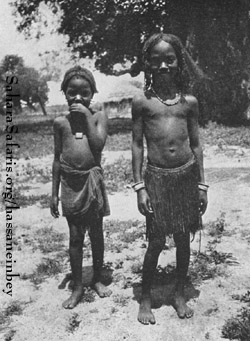BEGINNING THE ALL-NIGHT TREKS
With one-half of our objective achieved, I set
forth in high spirits on the short journey to Ouenat.
It was now the end of April, and since it had grown
intensely hot, I decided to leave Arkenu at 9:30 in the evening, thus
inaugurating our first all-night trek.
There is a tremendous advantage in night traveling,
for one never fails to march less than 12 hours and frequently the time
stretches to 13 and even 14, our longest continuous trek being for 14½
hours (between Ouenat and Erdi), covering a distance of a little more
than 40 miles.
The reason for the longer period of travel at night
is that, once a caravan gets under way after the intense heat of the day
is over—that is to say, between 4 and 6 o'clock in the afternoon—the
advance continues without respite until sunrise.
From 10 to 1 o'clock at night is the most trying
period of desert travel. It is then that the vitality of both men and
animals seems to be at lowest ebb, and there have been times between
these hours when I have felt that nothing
(p273)
would be quite so welcome as death, with its accompanying eternal sleep.

GIRLS OF THE
FOR TRIBE NEAR AL FASHER
They are wearing ivory and silver
bracelets. [photo page 274]
It becomes almost impossible to drag one foot after
the other, and only through the exercise of most rigid watchfulness can
sleep be fought off as fatigue increases.
But if night marches have their advantages, they
also have their disadvantages, such as difficult, rocky ground—bad going
for the feet of men and camels—and when there is no moon, danger of
missing one's way in crossing sand dunes, for the guiding star may be
lost.
But with the first break of dawn and the appearance
of light in the east, the desert traveler seems to take a miraculous new
lease on life. It is as if he had been suddenly rejuvenated. Miles seem
fairly to reel from beneath his feet, and there comes a jubilation of
spirit which is indescribable.
After this rebirth of energy, no desert traveler
would consent to halt. He's spurred on by an irresistible force, and
this urge continues until the sun has appeared above the horizon, giving
warning that the time of heat and suffering has arrived.
It is now that camp must be quickly made, tents
raised, food cooked and eaten; then a quick drop into the oblivion of
sleep which can last at most only for three or four hours. After that
heat becomes so intense that there is no opportunity for real relaxation
and comfort. It often happened that within 15 or 20 minutes from the
time that halt was called in the morning our entire camp would be
slumbering.
 
|
